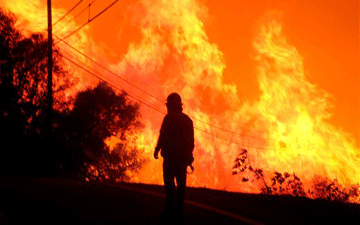
AP Photo/Mike Meadows)
Efren Oxlaj Tambito, Sam Packard, and Liz Rickley are environmental ethics fellows at the Markkula Center for Applied Ethics. Views are their own.
Before Californians can address the ethics of the recent spate of wildfires plaguing the state, it's important to get the facts about what is causing these disasters. What makes our state so prone to megafires?
Comparison between California and Climate Cousins
The past weeks have further displayed the severe issues that wildfires pose to California. The Camp, Woolsey, and Hill fires took lives and destroyed property, and many people are questioning why this issue is happening, what is causing it, and what we can do to remedy it.
First, it is important to understand the scope of the issue. Over the course of 2018, more than 7,000 wildfires have caused 1.6 percent of California’s land to burn [1]. With approximately 1,300 California communities designated by the National Fire Plan as being at high risk of damage from wildfire, the situation is clearly severe.
When comparing California to some of its “climate cousins,” or regions with similar environments, it becomes apparent that while extreme fires are not exclusive to California, they are far worse than would be expected. In comparison to its climate cousins, the percentage of land burned in California is more than twice as high as the next most affected region, British Columbia. This disparity suggests that there is more at play than just California’s dry climate.
What is Causing California Fires?
California is clearly not the only region in the world affected by wildfires, yet—at least in the North American continent—it appears to be the area most affected by significant economic loss and deaths. Wildfires are often ignited by natural causes, such as lightning, but the majority are caused by humans; this is especially true in California. To illustrate, the New York Times reports that 95 percent of fires are started by humans in California versus 84 percent for the rest of the nation [2]. Some fires begin unintentionally like the Carr Fire, which started when the rim of a truck scraped the asphalt and caused sparks to ignite the nearby vegetation. On a similar note, California’s dry and hot summers contribute to dense, dry vegetation and weak trees that easily fuel wildfires. In other regions of the state, like the Sierra Nevada, bark beetles often kill weak trees leading to the accumulation of more dry matter that can easily fuel and worsen wildfires [3]. Higher temperatures due to climate change are also expected to exacerbate these conditions because of less predictable rain patterns that can cause vegetation to dry faster.
However, hot weather and wildfires are not unique to California. Each year other western states like Oregon and Nevada face thousands of wildfires, but California has significantly more. For comparison, California and Oregon have experienced 6,210 and 1,055 wildfires, respectively, this year alone [4][5]. Indeed the higher number of wildfires explains some of the heavy economic losses in California, but not all. Another reason for the immense economic damage and loss of lives in California is that people are building homes in areas near forests that are prone to wildfires. These areas, known as the urban-wildland interface, experience fires as a natural part of the environment [2]. When homes are built, humans engage in fire suppression to protect their property, causing the accumulation of dry matter that would have otherwise burned if a fire had been allowed to burn. This creates the right conditions for more intense wildfires. When a wildfire does break out in such areas, any homes in its path are destroyed, leading to massive economic losses that could have been avoided if homes had been built in other places. As mentioned above, California has designated approximately 1,300 communities as being at high risk of damage from wildfires; some of these lie at this urban-wildland interface and others in places with significant dry vegetation. By building in these areas we continue to get closer to wildfires.
Why Control is So Difficult
California’s regional climate, as well as its terrain, make controlling wildfires especially challenging. The combination of drought and wind, partly due to the state’s mountains acting in places like wind tunnels, is a dangerous one. It only takes a small amount of wind to exacerbate a fire, and the recent Camp Fire in northern California experienced winds ranging from 50 to 70 miles per hour. Fire can always move fast, but these winds caused the fire to grow rapidly, ultimately resulting in the evacuation of Paradise before firefighting efforts had even begun. Likewise, during Southern California’s Woolsey fire, similar winds, known as the Santa Anas, increased the size of the fire from 8,000 acres to 35,000 acres in less than a single day. Not only do these winds impact the fires’ growth, but they create unpredictable, unfamiliar conditions for those on the ground; the already dangerous situation becomes drastically worse.
Conclusion
In conclusion, a combination of natural phenomena, a warmer climate, and questionable land management practices are contributing to California’s record-setting wildfires.
Sources
[1] State of California. California Statewide Fire Map. Retrieved from https://www.fire.ca.gov/incidents?page=8
[2] Pierre-Louis, Kendra. (2018, November 9). “Why does California Have so Many Wildfires?” Retrieved from https://www.nytimes.com/2018/11/09/climate/why-california-fires.html
[3] Lindsey, John. “Bark Beetles are killing trees in the Sierra Nevada at a record. Here’s why.” Retrieved from https://www.sanluisobispo.com/news/weather/weather-watch/article214901930.html
[4] State of California. Incident information. Retrieved from https://www.fire.ca.gov/incidents/
[5] Wildfire - Oregon Department of Forestry. Current information on department-protected lands. Retrieved from https://www.fire.ca.gov/incidents/
Other Resources
Arango, T. (2018, August 20). Behind Most Wildfires, a Person and a Spark: 'We Bring Fire With Us'. Retrieved from https://www.nytimes.com/2018/08/20/us/california-wildfires-human-causes-arson.html
British Columbia Wildfire Service. (2016, December 15). Wildfire Management. Retrieved from https://www2.gov.bc.ca/gov/content/industry/forestry/managing-our-forest-resources/wildfire-management
Facts + Statistics: Wildfires. Retrieved from https://www.iii.org/fact-statistic/facts-statistics-wildfires
Gibbens, S. (2018, November 12). Why California's wildfires are so hard to fight. Retrieved from https://www.nationalgeographic.com/environment/2018/11/why-woolsey-camp-california-wildfires-are-difficult-to-contain
State of California. Communities at Risk List. Retrieved from https://osfm.fire.ca.gov/divisions/wildfire-planning-engineering/fire-plan/communities-at-risk/
